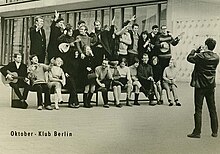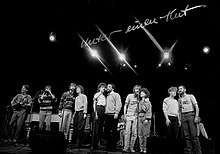Oktoberklub

Oktoberklub (English: October Club), initially known as the Hootenanny-Klub Berlin, was a political music group from the German Democratic Republic (GDR). The musical style of the group was a mixture of folk, chanson and rock music. It was founded in 1966 and existed until the group disbanded in 1990 after German reunification.
History[]
The folk revival in the United States sparked a wave of folk music and protest songs in many countries worldwide in the early 1960s. The Canadian folk singer had been organizing hootenannies in East Germany since 1960. A group of young people who became enthusiastic about folk music gathered around Friedman and the youth radio station DT64. With the support of the local FDJ district leadership they founded the Hootenanny-Klub Berlin in February 1966. The club was unusually informal by East German standards and everyone was encouraged to take part. Artists such as Manfred Krug, Bettina Wegner, Reiner Schöne and Gisela May.[1] began their careers in this club and went on to have television appearances in the GDR [2]

During its in December 1965, the SED leadership had decided to ban all critical art and youth culture, and in early 1967 staged a campaign against Anglicisms. As a result, the hootenanny movement in the GDR came to be officially referred to as the “FDJ ” and was subsequently appropriated and promoted as a “model case” of socialist cultural policy. It was under these conditions that the Hootenanny-Klub Berlin renamed itself as Oktoberklub. The goal of the change in name was to associate the group with the October Revolution and the foundation of the GDR.
According to , one of the groups singers, the members of Oktoberklub were "one hundred percent red, convinced, honest" and wanted to actively shape society. By combining politics with entertainment, they brought new elements into the frozen political culture of the GDR, but they were also instrumentalized for representational purposes by the SED and by their own account became "GDR-specific". This state of affairs led to arguments within the club, and some musicians such as Bettina Wegner left because of political differences. In the early years, the club had a remarkable response from young people who were loyal to the GDR, however those opposed to the SED rejected the club as “loyal to the line”, and by the 1980s its agitational songs were increasingly perceived as single-layered and sloganeering.
The club sang international political songs (partly in adaptations), traditional folk and battle songs as well as original creations. In addition to normal recitals with a mixed repertoire, they also performed revue-like programs from 1971 onwards (1971 FDJ-Nachtschicht, 1972 cantata Manne Klein and Liebesnachtschicht, 1975 Prenzlauer Berg).
The club was the principle organizer of a series of events such as the OKK (from 1970 the first permanent discotheque in the GDR, from 1977 the Kellerklub in the ), the Festival of Political Songs (1970-1990) and Ein Kessel Rotes (from 1979). The club also appeared frequently abroad, for example at press festivals of communist newspapers in Western Europe. The group received various awards, including the Gold Star of People's Friendship in 1986.
The club was an amateur group although at times it had a semi-professional core and the line-up changed frequently. Over the years, it had a grand total of about 180 members, although not all of them were artistically active. The writer Gisela Steineckert and the composer Wolfram Heicking played a mentoring role for the club for a long time. Important writers in the early years were Reinhold Andert, Kurt Demmler and , later Gerd Kern rose to prominence as lyricist and Fred Krüger as composer. From 1987 many texts and compositions were written by Michael Letz.
The club was also "of great importance as a talent reservoir for youth-oriented music" according to . In 1973 several former members of the club established a professional musical group known as Jahrgang 49, which existed until 1980. Some club members also pursued artistic solo careers (Reinhold Andert, Barbara Thalheim, Jürgen Walter, , Tamara Danz among others), while others later worked in cultural institutions or industries such as radio, television, recording or served in the general administration of the . Hartmut König became Deputy Minister for Culture in 1989.[3] The best known songs of the Oktoberklub include Sag mir, wo du stehst, Oktobersong and Wir sind überall. Other notable songs included tWir wollen Frieden, Haben wir diese Erde (a German version of the Argentine song Cuando tenga la tierra) and Rauch steigt vom Dach auf.
In 1968 portrayed the Oktoberklub in the DEFA documentary film Lieder machen Leute. In the 1990s, two television documentaries were made about the history of the club: Das Ende vom Lied (VPRO, Netherlands, 1992) and Sag mir, wo du stehst (Axel Grote and Christian Steinke, MDR 1993).
Publications and Discography[]
Brochures and books[]
- 1967: Octav (Song book for the Whitsun meeting of the FDJ in Karl-Marx-Stadt)
- 1985: 100 Lieder Oktoberklub. Berlin 1985
- 1996: Und das war im … 30 Jahre Oktoberklub. Die wichtigsten Daten und Dokumente von 1966–1990. Berlin 1996
LPs[]
- 1967: Der Oktoberklub singt (Amiga)
- 1968: Unterm Arm die Gitarre (Amiga)
- 1973: aha – Der Oktoberklub (Amiga)
- 1978: Politkirmes (Amiga)
- 1985: Da sind wir aber immer noch – 20 Jahre OK (Amiga, Double-LP)
Singles[]
- 1967: Was machen wir zu Pfingsten? / Reverse: Hermann Hähnel & Kammerchor Institut Musikerziehung Berlin ()
- 1967: Sag mir, wo du stehst / Reverse: Denn sie lehren die Kinder (Amiga)
- 1968: Friedenslied / Sommer '68 / Frühlingslied (Octav flexi disc, red label)
- 1969: Ich bin wie alle blind geboren / Heut' singt ein Singeclub (Octav flexi disc, green label)
- 1975: Große Fenster / Ich singe den Frieden (Amiga)
- 1978: Haben wir diese Erde? / Reverse: Jahrgang '49 with RDA grüßt Cuba socialista (Amiga)
- 1979: Da sind wir aber immer noch / Hier, wo ich lebe (Amiga)
CDs[]
- 1995: Das Beste (Barbarossa)
- 1996: Oktoberklub life (Nebelhorn)
- 1996: Hootenanny (Barbarossa/Amiga)
- 1999: Subbotnik (Barbarossa)
Further reading[]
- Ulrich Mählert, Gerd-Rüdiger Stephan: Blaue Hemden — Rote Fahnen. Die Geschichte der Freien Deutschen Jugend. Leske und Budrich, Opladen 1996, S. 175–178.
- Hagen Jahn: Jugend, Musik und Ideologie. Zur Geschichte der FDJ-Singebewegung. In: Hallische Beiträge zur Zeitgeschichte. Heft 12, 2002, S. 5–24 (PDF).
- David Robb (Hrsg.): Protest Song in East and West Germany Since the 1960s. Camden House, Rochester, NY 2007, darin ders.: Narrative Role-Play as Communication Strategy in German Protest Song, S. 67–96, hier S. 82 f. und ders.: Political Song in the GDR: The Cat-and-Mouse Game with Censorship and Institutions, S. 227–254, hier S. 233.
- Stefan Wolle: Der Traum von der Revolte. Die DDR 1968. Ch. Links, Berlin 2013 (Original 2008), S. 62 (E-Book).
- Gerd Dietrich: Kulturgeschichte der DDR. Vandenhoeck & Ruprecht, Göttingen 2018, S. 1183–1187.
External links[]
Commons: Oktoberklub – Album with pictures, videos and audio files
- Oktoberklub at Deutsche-Mugge
- Oktoberklub at Jugendopposition in der DDR
- Wolfgang Leyn: Singebewegung, Singeklub, Singegruppe. In: Folkszene-DDR
- Sarah Jost: „Unser Lied ist unser Kampf“. Das Festival „Politische Lieder zu den X.“ In: Kulturation Nr. 2, 2003.
- Theresa Beyer: Der Staat singt mit – das Lied in der DDR. In: Norient, 4. June 2013.
References[]
- ^ "CD-Box: "Hootenanny in Ost-Berlin" - Aufstieg und Niedergang der Folkszene in der DDR" (in German).
- ^ "Hootenanny in Ostberlin" (in German). 2016-01-06.
- ^ König schreibt in seiner Autobiographie auch ausführlich über den Oktoberklub, siehe ders.: Warten wir die Zukunft ab. Autobiografie. , Berlin 2017, Kapitel Prinzip Oktoberklub – die frühen Jahre (Vorschau).
- East German musical groups
- East German music